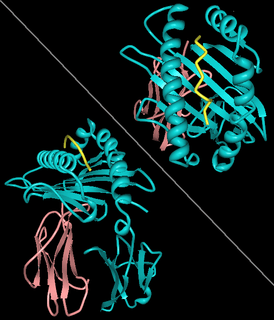Protein subunit

In structural biology, a protein subunit is a single protein molecule that assembles (or "coassembles") with other protein molecules to form a protein complex. Some naturally occurring proteins have a relatively small number of subunits and therefore described as oligomeric, for example hemoglobin or DNA polymerase. Others may consist from a very large number of subunits and therefore described as multimeric, for example microtubules and other cytoskeleton proteins. The subunits of a multimeric protein may be identical, homologous or totally dissimilar and dedicated to disparate tasks.
In some protein assemblies, one subunit may be a "catalytic subunit" that enzymatically catalyzes a reaction, whereas a "regulatory subunit" will facilitate or inhibit the activity. Although telomerase has telomerase reverse transcriptase as a catalytic subunit, regulation is accomplished by factors outside of the protein.[1] An enzyme composed of both regulatory and catalytic subunits when assembled is often referred to as a holoenzyme. For example, class I phosphoinositide 3-kinase is composed of a p110 catalytic subunit and a p85 regulatory subunit.[2] One subunit is made of one polypeptide chain. A polypeptide chain has one gene coding for it – meaning that a protein must have one gene for each unique subunit.
A subunit is often named with a Greek or Roman letter, and the numbers of this type of subunit in a protein is indicated by a subscript. For example, ATP synthase has a type of subunit called α. Three of these are present in the ATP synthase molecule, and is therefore designated α3. Larger groups of subunits can also the specified, like α3β3-hexamer and c-ring.
Subunit Vaccines
A subunit vaccine presents an antigen to the immune system without introducing viral particles, whole or otherwise. One method of production involves isolation of a specific protein from a virus and administering this by itself. A weakness of this technique is that isolated proteins can be denatured and will then become associated with antibodies different from the desired antibodies. A second method of making a subunit vaccine involves putting an antigen's gene from the targeted virus or bacterium into another virus (virus vector), yeast (yeast vector in the case of the hepatitis B vaccine[3] or attenuated bacterium (bacterial vector) to make a recombinant virus or bacteria to serve as the important component of a recombinant vaccine (called a recombinant subunit vaccine). The recombinant vector that is genomically modified will express the antigen. The antigen (one or more subunits of protein) is extracted from the vector.[4] Just like the highly successful subunit vaccines, the recombinant-vector-produced antigen will be of little to no risk to the patient. This is the type of vaccine currently in use for hepatitis B,[5] and it is experimentally popular, being used to try to develop new vaccines for difficult-to-vaccinate-against viruses such as ebolavirus and HIV.[6]
Vi capsular polysaccharide vaccine (ViCPS) is another subunit vaccine (contains the signature polysaccharide linked to the Vi capsular antigen), in this case, against typhoid caused by the Typhi serotype of Salmonella.[7] It is also called a conjugate vaccine, in which a polysaccharide antigen has been covalently attached to a carrier protein for T-cell-dependent antigen processing (utilizing MHC II).[8]
See also
References
- ↑ Daniel M, Peek GW, Tollefsbol TO (2012). "Regulation of the human catalytic subunit of telomerase (hTERT)". Gene (journal). 498 (2): 135–46. doi:10.1016/j.gene.2012.01.095. PMC 3312932
 . PMID 22381618.
. PMID 22381618. - ↑ Carpenter CL, Duckworth BC, Auger KR, Cohen B, Schaffhausen BS, Cantley LC (November 1990). "Purification and characterization of phosphoinositide 3-kinase from rat liver". J. Biol. Chem. 265 (32): 19704–11. PMID 2174051.
- ↑ "Recombivax". Retrieved May 5, 2013.
- ↑ "Recombivax". Retrieved May 5, 2013.
- ↑ "Recombivax". Retrieved May 5, 2013.
- ↑ Department of Veterinary Science & Microbiology at The University of Arizona Vaccines by Janet M. Decker, PhD
- ↑ Manuela Raffatellu, Daniela Chessa, R. Paul Wilson, Richard Dusold, Salvatore Rubino, Andreas J. Bäumler (June 2005). "The Vi Capsular Antigen of Salmonella enterica Serotype Typhi Reduces Toll-Like Receptor-Dependent Interleukin-8 Expression in the Intestinal Mucosa". Infect. Immun. 73 (6). pp. 3367–74. doi:10.1128/IAI.73.6.3367-3374.2005.
- ↑ Brenda A. Wilson, Abigail A. Salyers, Dixie D. Whitt, Malcolm E. Winkler. Bacterial Pathogenesis, A Molecular Approach, Third Edition. ASM Press, American Society for Microbiology, 1752 N St. NW, Washington, D.C. 20036-2904, copyrightyear=2011.
- Dilip Gore; Reecha Pandit (2011). "In silico Identification of Cell Surface Antigens in Neisseria meningitidis". Biomirror. 2: 1–5.